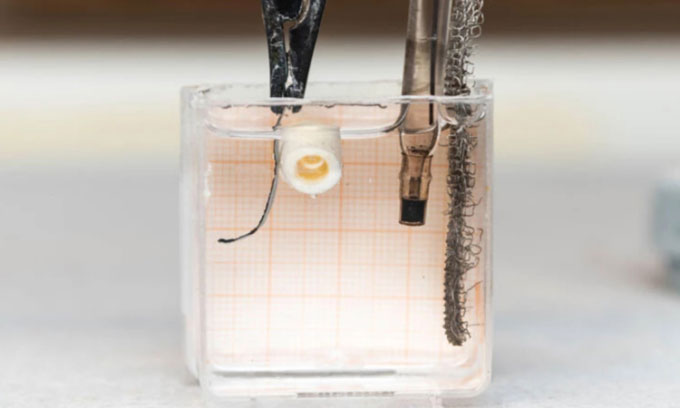Tiny robot helps mend broken bones in the body
World scientists develop new materials used to build robots, capable of expanding and filling the missing bone in the future.

Strip of material (leftmost) unwrapped around the chicken bone piece (white).
Complex fractures are not easy to treat, and sometimes it is necessary to remove the injured bone and replace it with bone from elsewhere in the body. However, thanks to a new material, microscopic "bone-forming" robots could provide a gentler solution in the future, New Atlas reported on January 17. The new study is published in the journal Advanced Materials.
The new technology is being developed by a team of scientists at Linköping University, Sweden, and Okayama University, Japan. It was inspired by the fontanelle tissue that helps an infant's skull become soft and flexible as it moves through the birth canal, then hardens into bone.
The new material takes the form of a thin band of alginate hydrogels derived from algae. One side of the gel is covered with an electrochemically active polymer called polypyrrole (PPy), and the other side contains biomolecules called plasma membrane nanoflakes (PMNFs) that are derived from cells.
When the team applied a low-voltage current to the material, PPy responded by increasing its volume. Since the polymer is only on one side, this reaction causes the strip of material to bend to one side. By cutting the material in different ways, the team was able to make it bend into different shapes, such as a semicircle or a spiral. Meanwhile, because PMNF originates from cells involved in bone development, they will naturally mineralize and harden like bone when placed in the human body.
Scientists hope to be able to put tiny robots made of this material into the site of complex fractures in the future. They expand and fill in the bone gaps when an electric current is applied. They will then harden into the bone and patch up the defect.
In experiments, the team of scientists succeeded in making the strips of material wrap themselves around chicken bones in a cell culture (chemically similar to the human body). These bands then grow into artificial bones that fuse with the chicken bones.
- The mystery of the broken bones in an ancient English village
- Successfully created the tiny robot can jump 10 times the height of the body
- Paper robot decomposed in the human body
- New tiny human bones were discovered in Palau
- Little known things about T-rays
- Tiny DNA robot that destroys cancer according to tactics
- Interesting facts about bones are not well known
- Why do Asians only have 204 bones while Europeans and Americans have 206?
- Revealing a super small robot just as light as a toothpick, can fly
- China introduces tiny robot that delivers drugs to kill cancer cells
- Puppy dog for pet lovers
- New research helps robots feel pain like humans
 The world's first sexless AI voice
The world's first sexless AI voice This cool t-shirt will make you invisible to AI
This cool t-shirt will make you invisible to AI AI can predict personality only through selfie photos
AI can predict personality only through selfie photos The world-famous chess player lost to Golaxy before, artificial intelligence 'made in China'
The world-famous chess player lost to Golaxy before, artificial intelligence 'made in China'